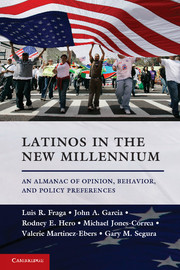Book contents
- Frontmatter
- Contents
- Acknowledgments
- 1 Latinos in the New Millennium
- 2 A Demographic Profile of Latinos in the United States
- 3 Core Values
- 4 Latino Identities
- 5 Latino Transnationalism
- 6 Intergroup Relations
- 7 Civic Engagement
- 8 Latino Media and Technology Usage
- 9 Voter Registration, Turnout, and Choice
- 10 Evolving Patterns and Preferences in Latino Partisanship
- 11 Latinos and Gender Role Attitudes
- 12 Latino Issues and Policy Preferences
- 13 Hope and Reality in Latino Educational Attainment
- 14 Latinos and the Future of American Politics
- Index
- References
5 - Latino Transnationalism
Continuities and Breaks with Countries of Origin
Published online by Cambridge University Press: 05 June 2012
- Frontmatter
- Contents
- Acknowledgments
- 1 Latinos in the New Millennium
- 2 A Demographic Profile of Latinos in the United States
- 3 Core Values
- 4 Latino Identities
- 5 Latino Transnationalism
- 6 Intergroup Relations
- 7 Civic Engagement
- 8 Latino Media and Technology Usage
- 9 Voter Registration, Turnout, and Choice
- 10 Evolving Patterns and Preferences in Latino Partisanship
- 11 Latinos and Gender Role Attitudes
- 12 Latino Issues and Policy Preferences
- 13 Hope and Reality in Latino Educational Attainment
- 14 Latinos and the Future of American Politics
- Index
- References
Summary
Transnationalism refers to the persistent ties that immigrants and their descendants have with their countries of origin. These ties can be social, such as maintaining contact with their friends and family; economic, for example, continuing to own land and businesses; or political, for instance, having an interest in, and taking part in, their country of origin's politics. Researchers characterize these transnational ties as made up of multiple attachments that stretch across national borders to make up a unified social world that is simultaneously located in two different places (Basch, Glick Schiller, and Szanton-Blanc 1994; Smith and Guarnizo 1998; Levitt and Glick Schiller 2004). Two leading immigration scholars describe how this occurs:
Over time and with extensive movement back and forth, communities of origin and destination increasingly comprise transnational circuits – social and geographic spaces that arise through the circulation of people, money, goods and information.…Over time, migrant communities become culturally “transnationalized,” incorporating ideologies, practices, expectations, and political claims from both societies to create a “culture of migration” that is distinct from the culture of both the sending and receiving nation. (Massey and Durand 1992, 8)
In this view, nation-states are seen as increasingly less relevant as an organizing principle of social interaction (Basch et al. 1994; Glick Schiller 1999; Portes 1999), facilitated by the ease of international travel and communication in an era of e-mail and Internet cafes, video-conferencing parlors in which immigrants can see and talk to the family they have left behind, instant money transfers, and cheap airfare.
Scholars generally use a few key indicators as measures of transnational ties: (1) the existence of organizational networks, such as immigrant hometown associations (Orozco 2000; Alarcón 2002; De la Garza and Hazan 2003); (2) immigrant attitudes and behaviors, such as engagement in remittance practices (i.e., immigrants sending money back to relatives in their countries of origin; Conway and Cohen 1998; Flores-Macias 2009); (3) travel back to immigrants’ countries of origin; and (4) the desire to one day live there again (Guarnizo 2000; Waldinger 2008. However, despite general agreement that the phenomenon of transnationalism exists, a number of disagreements and debates persist (Jones-Correa 2003; Waldinger and Fitzgerald 2004).
- Type
- Chapter
- Information
- Latinos in the New MillenniumAn Almanac of Opinion, Behavior, and Policy Preferences, pp. 101 - 142Publisher: Cambridge University PressPrint publication year: 2011



